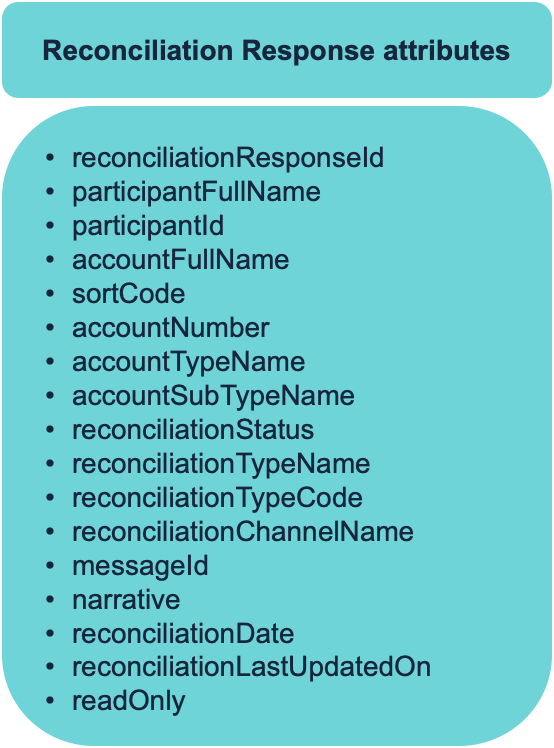Participants are expected to reconcile the accounts in their systems against the balance of their accounts in RTGS each day to ensure there are no mismatches. If there are mismatches, Participants can use the Reconciliation Responses API to log the details of the reconciliation mismatch for further investigation. The Reconciliation Responses API enables an organisation to:
- Create a reconciliation response
- Retrieve a specific reconciliation response

What can a Participant reconcile against:
- Participants can use the following messages for reconciliation that are triggered by RTGS each day:
- CAMT.053: CAMT.053: this is a statement message that is triggered by the RTGS at the end of each value day
- CAMT.052: this is a balance message that is sent at the start of each value day
- Participants can also request a CAMT.053 or CAMT.052 via a:
- CAMT.060: this is a message sent from the Participant to the Bank which requests the generation of an intraday CAMT.053 or an intraday CAMT.052
- Participants can also reconcile against
- UI downloads for Balance and Statement Reports
- Direct API calls for Balance and Statement Reports
Reconciliation Responses details:
Additionally, Participants can also use the Reconciliation Responses API to retrieve the details of a specific reconciliation response they are authorised to. Below are the list of attributes Participants can retrieve for a specific Reconciliation Response they have logged.

Below are some of the key Reconciliation attributes available for Participants using the Reconciliation Responses API.

Tasks:
Reconciliation Responses API may require Multi Step Review based on Participant's configuration. When an Update request is submitted the Participant will be returned a Task ID for every successful request RTGS receives. This Task ID can be used by the Participant to check the progress of the Update request. Once the request has reached its closure and if it is successful, Participant will be able to see the updates by retrieving the CHAPS Payments Controls. The various statuses a Task would go is explained in detailed in the Tasks API.
When Multi Step Review is enabled and the Participant has submitted the Update request via API channel, it mandates another user from the respective organisation to go to BERTI UI application and approve the Task requested via the API channel. In case Multi Step Review is enabled along with Dual Input required, the approver of the Task will have to key in the new values again. Dual Input Attempt field tracks the number of attempts when an approver performs blind dual input. Blind dual input is to allow an approver to input the same values as the requester without seeing what they have inputted. An approver has a total of 3 attempts to blindly input the same values as the initial API request post which the update request will be rejected.
Filter Values:
The Reconciliation Responses API has various fields thats have a predefined set of values e.g. Reconciliation Type, Reconciliation Channel etc. To retrieve the possible values of all these fields Participants can use the Filters API Get Resource by passing the relevant Resource Name of the field. For detailed information around fields thats have a predefined set of values across all RTGS API please refer to the following page Filter Values API.
Reconciliation Responses API Use Cases & Benefits
- Efficient and accurate matching of the books throughout the day
- Reconcile in real time
- Past reconciliation responses if any issues
- Reduce manual effort
Supported Developer Toolkit:
Bank of England RTGS APIs will be supported by Swift Microgateway and Swift SDK.Both solutions, provided by Swift, offer access to the APIs. Bank of England hosts a reference implementation based on Swift Microgateway and we can help you start with the API connectivity using this option.
If you are already a user of any of these solutions, just download the API Specification and follow the Swift recommended steps to import it into your implementation.